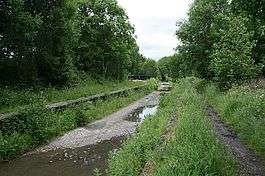Appin railway station
Appin was a railway station in Scotland, close to the Sound of Shuna on the east shore of Loch Laiche - an arm of Loch Linnhe, Portnacroish, Appin in Argyll and Bute.
| Appin | |
|---|---|
 Remains of Appin station | |
| Location | |
| Place | Portnacroish |
| Area | Argyll and Bute |
| Coordinates | 56.5713°N 5.3800°W |
| Operations | |
| Original company | Callander and Oban Railway Ballachulish Branch |
| Pre-grouping | Callander and Oban Railway operated by Caledonian Railway |
| Post-grouping | LMS |
| Platforms | 2 |
| History | |
| 24 August 1903 | Opened |
| 25 May 1953 | Closed |
| 24 August 1953 | Re-opened |
| 28 March 1966 | Closed |
| Disused railway stations in the United Kingdom | |
| Closed railway stations in Britain A B C D–F G H–J K–L M–O P–R S T–V W–Z | |
History
This station opened on 24 August 1903.[1] It was laid out with two platforms, one on either side of a crossing loop. There were sidings on both sides of the line.
Opened by the Callander and Oban Railway, it joined the London, Midland and Scottish Railway during the Grouping of 1923. Passing on to the Scottish Region of British Railways on nationalisation in 1948.
The station was temporarily closed from 25 May to 24 August 1953 when flooding washed away a bridge.[2] It was then closed by the British Railways Board in 1966, when the Ballachulish Branch of the Callander and Oban Railway was closed.[1][3]
The station had been the location of two LMS caravans from 1935 to 1939.[4] A camping coach was also positioned here by the Scottish Region from 1952 to 1965.[5]
| Preceding station | Historical railways | Following station | ||
|---|---|---|---|---|
| Creagan Line and station closed |
Callander and Oban Railway Ballachulish Branch Caledonian Railway |
Duror Line and station closed | ||
Signalling
Throughout its existence, signalling on the Ballachulish Branch used the electric token system. Appin signal box was located on the Down platform, on the west side of the railway. It had 24 levers.
References
Notes
- Butt (1995), page 17
- "Railway Reopens". Dundee Courier. 19 August 1953. p. 4. Retrieved 26 June 2020. – via britishnewspaperarchive.co.uk (subscription required)
- Hurst (1992), page 43 (ref 1943)
- McRae (1997), page 22
- McRae (1998), page 13
Sources
- Butt, R. V. J. (1995). The Directory of Railway Stations: details every public and private passenger station, halt, platform and stopping place, past and present (1st ed.). Sparkford: Patrick Stephens Ltd. ISBN 978-1-85260-508-7. OCLC 60251199.
- Hurst, Geoffrey (1992). Register of Closed Railways: 1948-1991. Worksop, Nottinghamshire: Milepost Publications. ISBN 0-9477-9618-5.
- McRae, Andrew (1997). British Railway Camping Coach Holidays: The 1930s & British Railways (London Midland Region). Scenes from the Past: 30 (Part One). Foxline. ISBN 1-870119-48-7.
- McRae, Andrew (1998). British Railways Camping Coach Holidays: A Tour of Britain in the 1950s and 1960s. Scenes from the Past: 30 (Part Two). Foxline. ISBN 1-870119-53-3.
Further reading
- Fryer, Charles (1989). The Callander and Oban Railway. Oxford: Oakwood Press. ISBN 0-8536-1377-X. OCLC 21870958.
- Jowett, Alan (March 1989). Jowett's Railway Atlas of Great Britain and Ireland: From Pre-Grouping to the Present Day (1st ed.). Sparkford: Patrick Stephens Ltd. ISBN 978-1-85260-086-0. OCLC 22311137.